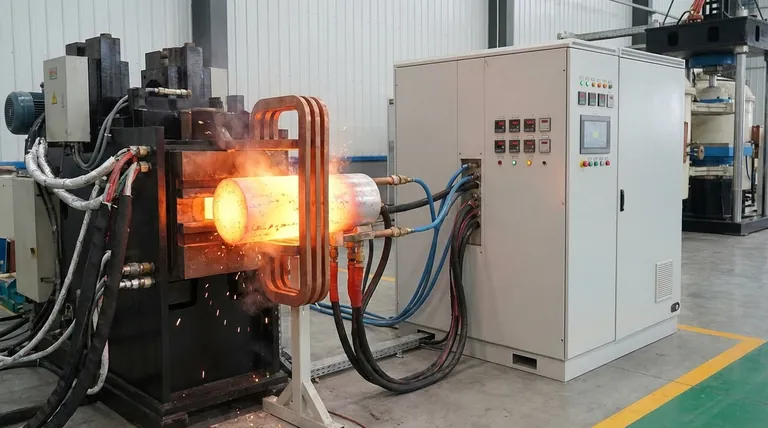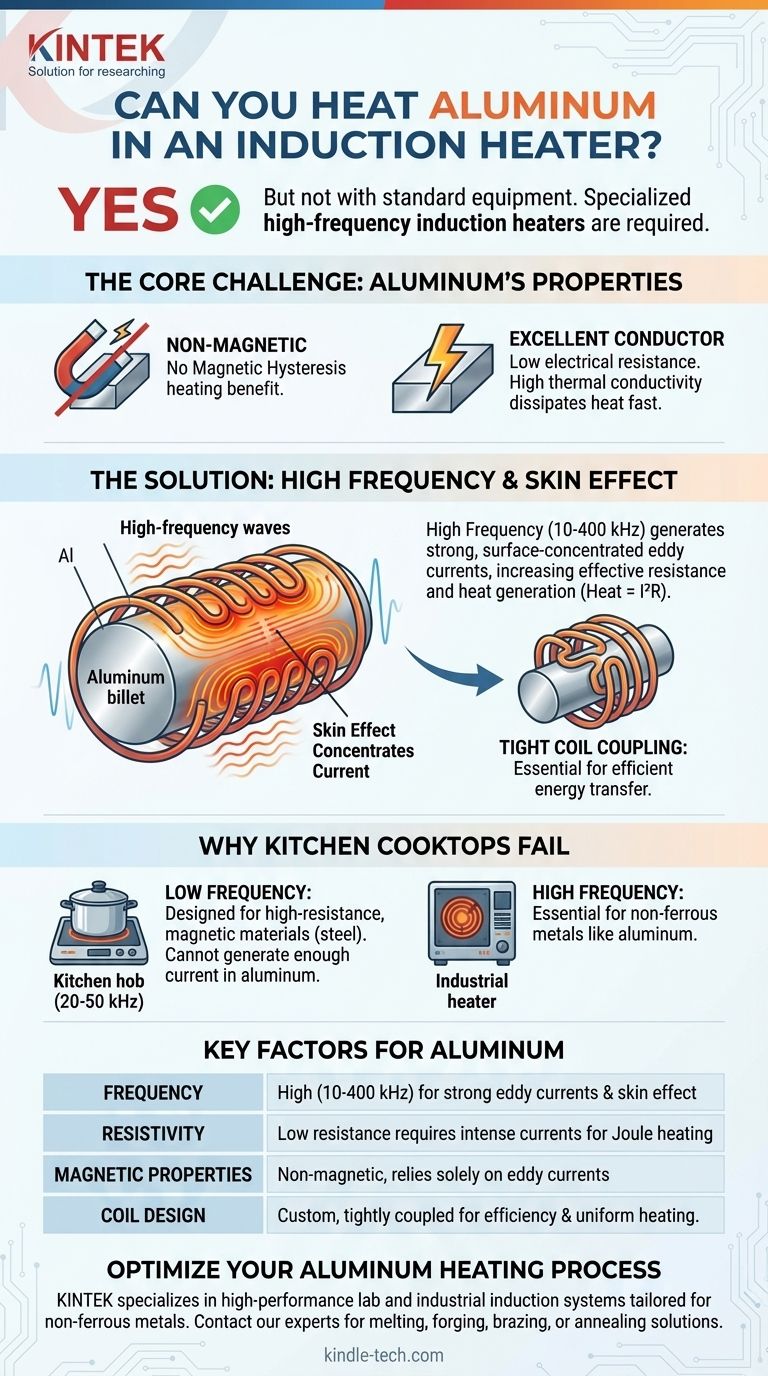Yes, but not with the equipment you might expect. While a standard kitchen induction cooktop will not heat an aluminum pan, specialized industrial induction heaters can heat and even melt aluminum with remarkable efficiency. The success of heating aluminum via induction hinges entirely on using the correct frequency and power.
The core challenge is that aluminum is non-magnetic and an excellent electrical conductor. To overcome this, you must use a high-frequency induction system that can generate intense eddy currents near the material's surface, producing the necessary heat faster than the aluminum can conduct it away.

How Induction Heating Fundamentally Works
To understand why aluminum is a special case, we first need to review the core principles of induction.
The Role of a Magnetic Field
An induction heater uses a coil of wire through which a high-frequency alternating current (AC) is passed. This creates a powerful and rapidly changing magnetic field in the space around and within the coil.
Generating Heat with Eddy Currents
When a conductive material like aluminum is placed within this magnetic field, the field induces circular electrical currents inside the material. These are known as eddy currents.
The Importance of Resistance
These eddy currents flow through the material's natural electrical resistance. This process generates precise and instantaneous heat directly within the part, a phenomenon described by Joule's first law (Heat = Current² × Resistance).
Why Aluminum Presents a Challenge
The properties that make aluminum a valuable material—its low weight and high conductivity—also make it difficult to heat with common induction systems.
The Problem of Low Resistivity
Aluminum is an excellent conductor of electricity, meaning it has very low electrical resistance. According to the Joule heating formula, if the resistance (R) is very low, you need to generate an enormous amount of current (I) to produce significant heat.
The Absence of Magnetic Hysteresis
For ferromagnetic materials like iron and steel, a secondary heating effect called magnetic hysteresis provides a significant boost, especially at lower temperatures. Because aluminum is non-magnetic (paramagnetic), it gets zero heating benefit from this effect, placing the entire burden on eddy currents.
The Solution: High Frequency and Coil Design
Overcoming aluminum's low resistance requires a specific engineering approach. The key variable is not power alone, but frequency.
Overcoming Low Resistance with Frequency
The strength of the induced eddy currents is directly proportional to the frequency of the magnetic field. By using a high-frequency power source (typically 10 kHz to 400 kHz), we can induce much stronger eddy currents in the aluminum.
Furthermore, higher frequencies cause the currents to concentrate in a thin layer near the surface of the material. This is called the skin effect. Concentrating the current into a smaller cross-sectional area effectively increases the resistance, dramatically increasing the heating effect (Heat = I²R).
Why Your Kitchen Cooktop Fails
Standard induction cooktops operate at a very low frequency (typically 20-50 kHz) and are specifically designed to work with high-resistance, magnetic materials like cast iron or stainless steel. They simply cannot generate a strong enough current in aluminum to produce heat. Many also have sensors that prevent them from activating if they don't detect ferromagnetic cookware.
The Importance of a Well-Coupled Coil
Energy transfer is most efficient when the induction coil is close to the workpiece. This is known as tight coupling. For industrial applications, coils are custom-designed to match the shape of the aluminum part, ensuring maximum efficiency and uniform heating.
Understanding the Trade-offs and Considerations
While effective, using induction to heat aluminum involves specific technical and financial considerations.
Equipment Cost and Complexity
High-frequency induction power supplies are more complex and costly than the low-frequency systems used for steel. The design of the coil and the overall system requires specialized expertise.
High Power Requirements
Aluminum has high thermal conductivity, meaning it dissipates heat very quickly throughout its mass. To reach forging or melting temperatures, the induction system must deliver power very rapidly, overwhelming the material's ability to conduct the heat away from the surface.
Alloy Differences
Different aluminum alloys have slight variations in electrical resistivity. These differences can affect the ideal frequency and power settings needed to achieve a target temperature in a specific amount of time.
Making the Right Choice for Your Goal
Your approach depends entirely on your objective.
- If your primary focus is cooking at home: Do not use pure aluminum pans. Instead, choose induction-ready cookware that has a built-in ferromagnetic base layer.
- If your primary focus is a hobby project like melting small amounts of aluminum: You will need a dedicated, benchtop high-frequency induction furnace designed specifically for non-ferrous metals.
- If your primary focus is an industrial process (forging, brazing, or annealing): You must partner with an induction heating specialist to engineer a system with the correct frequency, power, and coil design for your specific aluminum alloy and part geometry.
Ultimately, heating aluminum with induction is a solved problem in engineering, requiring the right tool for the job.
Summary Table:
| Key Factor | Why It Matters for Aluminum |
|---|---|
| Frequency | High frequency (10-400 kHz) is required to generate strong eddy currents and utilize the skin effect for effective heating. |
| Resistivity | Aluminum's low electrical resistance requires intense currents to generate significant heat via Joule heating. |
| Magnetic Properties | Being non-magnetic, aluminum lacks the hysteresis heating benefit, relying solely on eddy currents. |
| Coil Design | Tightly coupled, custom-shaped coils are essential for efficient energy transfer and uniform heating. |
Ready to heat aluminum efficiently in your lab or production line? KINTEK specializes in high-performance lab equipment, including industrial induction heating systems tailored for non-ferrous metals like aluminum. Our experts will help you select the right high-frequency system and coil design for your specific alloy and application—whether it's for melting, forging, brazing, or annealing. Contact us today to optimize your aluminum heating process with precision and reliability!
Visual Guide

Related Products
- 600T Vacuum Induction Hot Press Furnace for Heat Treat and Sintering
- Vacuum Heat Treat Furnace and Levitation Induction Melting Furnace
- 1400℃ Laboratory Quartz Tube Furnace with Alumina Tube Tubular Furnace
- 1800℃ Muffle Oven Furnace for Laboratory
- 1700℃ Laboratory Quartz Tube Furnace with Alumina Tube Tubular Furnace
People Also Ask
- Is brazing or welding cheaper? A Detailed Cost Analysis for Your Project
- Can you get an electrical arc in vacuum? How High Voltage Creates Plasma in a Void
- What products are made by hot pressing? Achieve Maximum Density and Performance for Your Components
- What does bond strength depend on in braze welding? Master the 3 Keys to a Strong Joint
- Why are brazed joints subjected to fatigue failure? Understanding the Critical Factors for Long-Lasting Joints



















